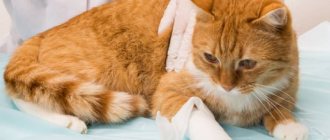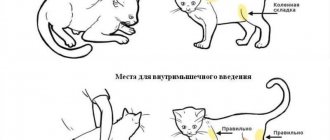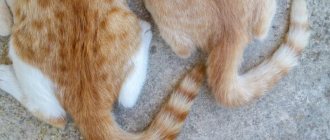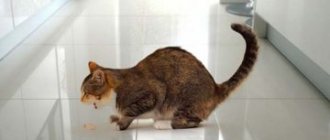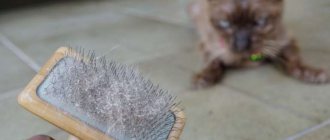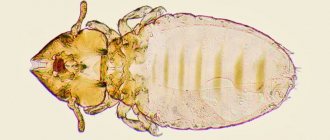Having noticed a small ulcer in the area of the upper or lower lip of his pet, the owner rarely attaches importance, believing that such a wound will go away on its own and will not cause harm to the body. If the wound is not large, formed on the skin near the lip or mucous membrane as a result of injury from rough food or during a fight with a relative, then it actually heals quickly over time and leaves no trace.
Even though the damage may seem minor, veterinarians recommend treating the affected area with a disinfectant solution to prevent bacterial infections.
In some cases, a sore seen on a cat's lip is a more serious injury caused by the herpes virus or a disease - eosinophilic granuloma. Failure to start treatment in a timely manner and incorrect diagnosis lead to serious changes.
Thus, the herpes virus greatly weakens the animal’s immunity and, against the background of primary infection, pathological conditions such as rhinotracheitis develop. This disease is characterized by constant mucus discharge from the nasal passages, sneezing and coughing. When sneezing, mucus from the nose and saliva from the mouth, infected with viruses, enter the eyes, which also leads to eye damage. Infected eyes constantly water, swelling develops, and crusts of dried exudate form.
The herpes virus almost constantly circulates in the animal’s body, being in “sleeping” mode. With a decrease in immune defense, violation of the rules of keeping and hygiene of the cat, poor quality feeding, the virus manifests itself, turning into an acute form. The owner’s task is to promptly identify pathological changes and contact a veterinary clinic for examination with qualified staff.
The main causes of Jacobs disease
Unfortunately, there is no information about the true causes of this disease.
But veterinary medicine has several theories on this matter. One assumption is that the origin of the disease is allergic in nature. The lip ulcer in Jacobs disease consists of many eosinophils. And when an allergen enters an animal’s body, eosinophils are produced in huge quantities.
Another theory is that the ulcer is of viral etiology. There are known cases where antibodies to the leukemia virus were found in the blood of a cat during Jacobs disease. But this is more likely to be due to low immunity than to the feline leukemia virus.
Another possible origin is the presence of ectoparasites in the cat, such as fleas or ticks. And the ulcer on the lip in this case is an allergic reaction to the saliva of parasites.
One known predisposing factor to the formation of ulcers on a cat's lip is the use of plastic bowls. Therefore, in case of possible relapses, the best solution would be to use metal utensils.
Cat scratch disease (felinosis) - symptoms and treatment
Cat scratch disease (cat scratch fever, felinosis, or regional nonbacterial lymphadenitis) is an acute bacterial zoonotic infection transmitted primarily from cats. It is characterized by regional lymphadenitis (inflammation of the lymph nodes), skin rash, and sometimes damage to the eyes, nervous system, and internal organs.[1]
The cause of the disease is infection with the bacterium Bartonella henselae, which has been isolated from humans and mammals and is a small pleomorphic, facultative, gram-negative and intracellular bacillus.
Sources of infection
Cats are a natural reservoir and carrier of B. henselae, and the animals themselves are not affected by it. In a number of studies conducted in the USA, 28% of examined cats had antibodies against the causative bacterium, and of these, 56% of kittens younger than one year and 34% of cats one year and older were immune to the bacillus. The study also showed that stray cats (61%) had B. henselae in their blood much more often than domestic cats (21%).[2]
Kittens younger than 12 months are 15 times more likely to transmit the infection than adult cats due to the presence of B. henselae bacteria in the blood and a greater tendency to scratch.
Transmission of infection between cats occurs through the bite of the cat flea Ctenocephalides felis or ingestion of their waste products. Therefore, people who have at least one kitten with fleas in their home are 29 times more likely to become infected with bacillus than those whose animals did not have fleas in their fur.[3]
Dogs are also a source of infection, but much less frequently than cats - only 5% of cases.[4] Isolated cases of the disease occurring in human contact with guinea pigs, rabbits and monkeys have also been reported.[1]
Among other things, the role of Ixodes ricinus (dog tick) in the transmission of infection has been proven, which often attacks people.[5] A case of familial infection with Bartonella due to their bites has been described.[6]
Transmission to humans from cat flea bites and from person to person has not been confirmed.[2]
Ways of transmission of infection:
- Scratches . 75-90% of patients with felinosis shortly before the onset of the disease noted superficial skin trauma during contact with a cat. The fact is that fleas, while on an animal, excrete excrement that contains bacteria. When a cat scratches its skin (for example, by scratching), its claw becomes contaminated with waste material, which can then transmit the infection to humans when it is injured.[1]
- Bites and salivation on injured skin are associated with the presence of bacteria in the saliva of animals.[1]
The prevalence of the disease in the world and in the Russian Federation is not known. The incidence in the United States among outpatients is approximately 9.3 cases per 100,000 people per year, with up to 20,000 new cases reported annually.[7] Approximately 70-90% of cases occur during the fall and early winter months. It is assumed that seasonality is associated with an increase in the birth rate of kittens in mid-summer and with an increase in flea infestation.[8]
At-risk groups
The disease is more common in people under 18 years of age (55 to 80% of cases). This is due to the fact that it is children and teenagers who most often play with kittens.[9]
It is also worth noting that the disease is more common in men than in women, in a ratio of 3:2. One hypothesis to explain the higher incidence among males is a tendency to play rougher with kittens and cats and therefore have an increased risk of biting and scratching.[1]
How to treat lip ulcers on a cat
Treatment of the disease is complex, usually with local external treatment with solutions plus the use of corticosteroids, vitamins and immunocorrectors. The disease should not be neglected; it is easy to get rid of without complications. You just need to contact a veterinary clinic in a timely manner and strictly follow the doctor’s instructions.
Sign up for treatment for Jacobs disease
POLAR BEAR
The veterinary clinic in Nizhny Novgorod "White Bear" provides all types of services for cats and dogs.
Conducts any examinations and tests in its own veterinary laboratory; the clinic operates a veterinary ambulance for animals and a 24-hour veterinarian is on call at home. Agreement on the processing of personal data
Public offer
SITE MENU
- About the clinic
- Price list for veterinary clinic services
- Treatment
- Services
- Price list for veterinary clinic services
- Vetapteka
- Contacts
- Site Map
CONTACTS
- Nizhny Novgorod st. Vyatskaya 7
- 8 (831) 437-25-27
- [email protected]
Oral tumors in dogs and cats
In general, tongue tumors are quite rare. According to one study, 54% of tongue lesions are neoplastic, 64% of which are malignant tumors (Dennis MM et al. 2006). Breed predisposition: Chow Chow and Shar Pei to malignant melanoma; poodles and Labrador retrievers and Samoyeds for squamous cell carcinoma; border collies and golden retrievers to hemangiosarcoma and fibrosarcoma; cocker spaniels to plasmacytic neoplasms. The most common neoplasm of the tongue in dogs is squamous cell carcinoma (50% of all cases), followed by granular cell myoblastoma, malignant melanoma, mastocytoma, fibrosarcoma, adenocarcinoma, neurofibrosarcoma, leiomyosarcoma, hemangiosarcoma, hemangioma, rhabdomyoma, rhabdomyosarcoma, myxoma and lipoma (Carpenter LG et al. 1993; Brodey RS, 1960). In cats, squamous cell carcinoma is mainly diagnosed, most often located in the area of the base of the tongue or on its ventral surface. Clinical symptoms are generally similar to other oral neoplasms.
An incisional biopsy can be performed under general anesthesia (often requiring several stitches to stop bleeding). A biopsy is necessary to differentiate neoplasms from non-neoplastic lesions such as eosinophilic granuloma, inflammation and calcification circumscripta. In animals with tongue tumors, fine-needle biopsy of regional lymph nodes and chest x-ray should be performed to determine the stage of the disease.
The main treatment is surgical resection of the tumor, but radiation therapy can be used in animals with malignant melanoma, inoperable cancer, or metastatic disease of the lymph nodes. In general, according to a number of studies, resection of 50 to 100% of tongue tissue is well tolerated by animals with minimal reduction in quality of life (Dvorak LD et al. 2004). However, in the postoperative period, the animal will require a stoma to provide enteral nutrition, and the time frame for adaptation to life after surgery varies significantly. Over the long term, most animals adapt to consuming their own water and food. The main problem after such operations is hypersalivation. Thermoregulation can be a problem in animals living in hot climates. Improper grooming in cats can cause poor coat condition.
The prognosis for tongue tumors depends on the location, type and stage of the tumor process. The degree of malignancy of squamous cell carcinoma in dogs is divided into grades I-III, depending on the degree of differentiation and keratinization, mitotic index, vascular and tissue invasion, as well as nuclear pleomorphism. The median life expectancy in dogs with grade I squamous cell carcinoma is 16 months after surgical resection of the tumor, and grades II and III are 4 and 3 months, respectively. Long-term control in cats with RCC is rarely achievable and 1-year survival is less than 25%.
Granular cell myoblastoma is a curable disease (Turk MM et al. 1983). These tumors may appear bulky and invasive but respond well to surgical removal with minimal resection margins. Local tumor control reaches 80%; relapses may occur; however, repeat resection is possible. Metastasis is rare.
For other neoplasms, the biological behavior is generally similar to other localizations.
What to do if your cat has a swollen lower lip
Even if the cause of swollen lips in a cat is obvious, it is still better to take the animal for examination to a veterinarian rather than self-medicate. The doctor will conduct an examination, tests (this will help rule out similar diseases) and prescribe the most appropriate treatment:
- Dental diseases are treated with anti-inflammatory drugs (for example, Prednisolone is used), and the gums are washed with antiseptic solutions. Plaque must be cleaned and tartar removed. If necessary, a tooth is removed in the area where inflammation occurred.
- If you have an allergy, the first thing to do is to interrupt contact with the allergen (stop giving the food to which the reaction occurred, wash off the applied product from the skin). Then the cat is given antihistamines:
- Suprastin;
Suprastin suppresses allergic reactions - Hydroxyzine;
- Chlorpheniramine.
Diphenhydramine;
When the cause is a fungal infection, they use drugs like Fungivet cream, Zoomikol, Imaverol. If an abscess has formed on the cat's lip, the doctor opens it and squeezes out the purulent contents. The procedure is performed under local anesthesia. After opening, a bandage is applied with a hypertonic solution and antibacterial ointments. Imaverol is prescribed in cases of fungal infections
To do this, the affected area is washed with clean water, treated with a weak solution of potassium permanganate, and an anti-burn or bactericidal ointment is applied (Levomekol, Sangel, Sanatol, Ranosan are suitable). Then you need to apply a bandage to the lower jaw. Bandages must be changed every day. Levomekol prevents infection of the burn surface
For rapidly growing tumors or if drug therapy is ineffective, surgery is prescribed. For any reason for swollen lips, it is recommended to use a veterinary collar during treatment, which will avoid scratching the affected area and will not allow the cat to remove the applied bandage.
If a cat has swelling of the lower lip, it is necessary to carefully examine the animal for wounds, burns and other distinctive signs. If the cause is not obvious, only a veterinarian can make a diagnosis. Once the source of the problem is identified, treatment must begin immediately. You can’t let things take their course, since many diseases accompanied by swollen lips progress quickly and pose a danger to the cat’s life.
How to determine the disease?
More often the upper lip is affected on the right or left, less often on both sides at once. The ulcer has a clearly defined outline, its color is closer to brown, its size is 0.2-5 cm. There is no itching or pain, the pet clearly feels discomfort only at the time of eating or drinking. Therefore, the owner may notice that the pet has begun to avoid bowls. Additionally, the following can be found on the surface:
- plaques;
- miliary dermatitis;
- granulomas.
The same patient may experience different manifestations simultaneously. The localization of various manifestations of the disease can be: the abdomen or thigh, back or neck, lower lip or gums.
To exclude further manifestations of allergic dermatitis, it is recommended to conduct a special test. It will allow you to identify the problem to which the body develops a negative reaction. Often, tailed pets are allergic to dust, tobacco smoke, pollen, and mold.
Chronic gingivostomatitis (caudal stomatitis) in cats
Gingivostomatitis is an inflammation of the gum tissue and oral mucosa. In the chronic course, ulcers are formed, the affected areas are most often the gums, the mucous membrane of the cheek and palate, the larynx, the mucous membranes of the posterior surface of the oral cavity, the area of the palatoglossal arch and tongue.
The etiology of caudal stomatitis has not been established.
It is believed that the development of gingivostomatitis may be influenced by:
- Calcivirus (common).
- Immunodeficiency and leukemia (less common).
- Bartonella henselae (less common).
- The intensity of the inflammatory response to bacterial plaque (most often).
Clinical manifestations of the disease are unpleasant odor from the mouth (halitosis), swallowing disorder (dysphagia), refusal to eat, lack of appetite, increased salivation (hypersalivation).
To make a diagnosis it is necessary:
1. Rule out viral infections.
2. Visual examination of the animal.
3. X-ray according to indications.
4. Tissue biopsy according to indications.
Indications for which radiography or tissue biopsy are necessary are suspicion of a neoplasm.
The goal of treatment is to eliminate the causes of inflammation; more often, conservative (drug) treatment does not produce any results, therefore, in animals with caudal stomatitis, it is recommended to remove all premolars and molars; canines and incisors can be left if the inflammation of the gums has not spread. If the inflammation has spread, it is recommended to remove the entire arcade of teeth (upper and lower); radiography after complete extraction is necessary for control; if the removal is not done well, stomatitis will remain against the background of root fragments. As a rule, this gives positive dynamics in the treatment of this pathology.
If the owners refuse radical measures, you can try sanitation of the oral cavity (ultrasonic cleaning, polishing) in combination with drug treatment, there is a positive trend, but not significant, often such treatment is temporary, while taking or stopping taking antibacterial drugs there are risks of relapse big enough.
Help your pet
If your cat has swelling of the upper or lower lip, you should not let the situation take its course. Most often, the cause of swelling is a scratch, irritation or an insect bite, but there is no need to discard options that are more dangerous to the health and life of the animal.
Every person who has a pet in their home should have the necessary medications, in particular antiseptics, on hand. First medical aid when a tumor-like formation is detected on the tissues of the oral cavity in a cat requires antiseptic treatment and diagnosis.
It is best to show the animal to a veterinarian, who will make a professional diagnosis and prescribe treatment. Please note that treatment methods (observation, therapeutic support or surgical intervention) depend on the diagnosis, the course of the disease and the condition of the animal.
Features of cat claws
Your cat's claws are different from human nails. Our nails are flat and sit on top of the tips of our fingers and toes, providing protection for our fingers. Cat claws, on the other hand, extend from the front of the toes and act as tools for catching prey and tearing meat from bones.
Cats typically have five clawed toes on each of their front paws and four on each of their hind paws. Some animals, known as polydacts, may have more. This does not bring them any discomfort and is a normal option. The shorter and opposite toes on the front paws (they resemble human thumbs) are called dewclaws. The cat needs them in order to firmly hold the caught object.
Your pet's claws do not retract completely into the paw. If you look closely at a cat with retracted claws, you will notice their protruding tips. When a pet wants to use its claws for their intended purpose, it squeezes the tendons to pull them out and down.
Cats' ability to partially retract their claws means that when the animal walks, they do not touch the ground. This reduces wear on the claws and ensures they are sharp.
Cat claws have a curved shape. This helps when hunting or playing, but increases the risk of getting caught in carpet loops, leather upholstery, and fur items. Thus, even the most careful pet can break or tear off a claw.
Cat claws grow continuously. In this they are exactly similar to human nails. The outer sheaths of the nails, which become dull over time, are shed when the animal scratches at the scratching post or other things.
If you look closely at a cat's claw, you can see a pinkish part inside it. This is the so-called “living” part of the claws, which contains blood vessels and nerves. Never trim a nail close to it: if you touch it, it will bleed and it will be very painful for your pet.
Odontoclastic resorptive lesions of teeth in cats (FORLs)
Odontoclastic resorptive lesion is not carious destruction. Defects are often replaced by hyperplastic gums, dental deposits (tartar, soft plaque), and pulp tissue.
There are types 1 and 2:
- Type 1 – destruction that does not lead to the replacement of destroyed roots with bone tissue. The radiography clearly shows the roots and periodontal ligament.
- Type 2 – destruction, leading to the replacement of destroyed roots with bone tissue. On radiography there are no clear boundaries of the root or it may not exist at all; the periodontal ligament is not visualized.
Pathology such as resorption is common in cats. The reason why this disease occurs is not known; there are many theories, but none of them have been proven.
The first stage of damage is a cement defect, odontoclasts destroy enamel and dentin, and a resorptive cavity is formed. The pulp chamber is exposed, high sensitivity and pain appear, the crown often breaks, and the roots remain in the alveolus. Bleeding gums appear, because... sharp edges of the enamel constantly injure the mucous membrane. The formation of mineralized plaque on the surface is common.
Clinically, interest in food is manifested, but it is painful to take food, bleeding gums in the area of the affected teeth, a lack of integrity of the crown can often be observed, the affected part of the crown is replaced by gums or dental deposits.
To make a diagnosis, an examination of the oral cavity by a specialist and radiography is sufficient.
Resorptive teeth are a source of infection, so the only adequate treatment is complete extraction, i.e. removal and careful curettage of the hole.
Often the disease progresses and parallel teeth are susceptible to destruction.
The cat's lower lip is swollen: associated symptoms
Regardless of the cause of inflammation, swelling develops around the lip. The skin begins to peel, turns red, and ulcerations appear.
The cat has difficulty eating, as well as the following accompanying symptoms:
- loss of appetite or refusal to eat due to pain while eating.
- profuse drooling;
- resistance when the owner tries to examine the mouth and aggressive rumbling;
- bad breath;
- swelling of the muzzle due to inflamed salivary glands;
- the tongue is hyperemic or has a dirty gray coating on it;
- the animal is losing weight;
- the coat loses its shine and becomes disheveled.



